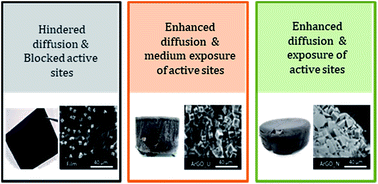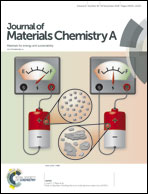Pathways towards high performance Na–O2 batteries: tailoring graphene aerogel cathode porosity & nanostructure†
Abstract
Fundamental understanding of the physical phenomena and electrochemical reactions occurring in metal–air batteries is critical for developing rational approaches towards high-performing Na–O2 battery cathodes. In this context, air cathode porosity plays a key role in battery performance, influencing oxygen supply and hence oxygen reduction and evolution reaction kinetics (ORR/OER). Graphene-based aerogels offer great versatility as air-cathodes due to their low density, high electronic conductivity and adjustable porosity. Reduced graphene aerogels with different porosities are examined where high meso-macroporosity and a narrow macropore size arrangement exhibit the best electrode performance among all studied materials (6.61 mA h cm−2). This is ascribed to the particular macroporous 3D structure of graphene-based electrodes, which favours the diffusion of oxygen to the defect sites in graphene sheets. An outstanding cycle life is achieved by using the pore-tuned cathode, leading to 39 cycles (486 h) at 0.5 mA h cm−2 with very low overpotential (250 mV) and efficiency over 95%. The cyclability is further increased to 745 h (128 cycles) by decreasing the capacity cut-off. This study shows that tuning of material porosity opens a new avenue of research for achieving Na–O2 batteries with high performance by maximizing the effective area of the electrodes for the ORR/OER.



 Please wait while we load your content...
Please wait while we load your content...